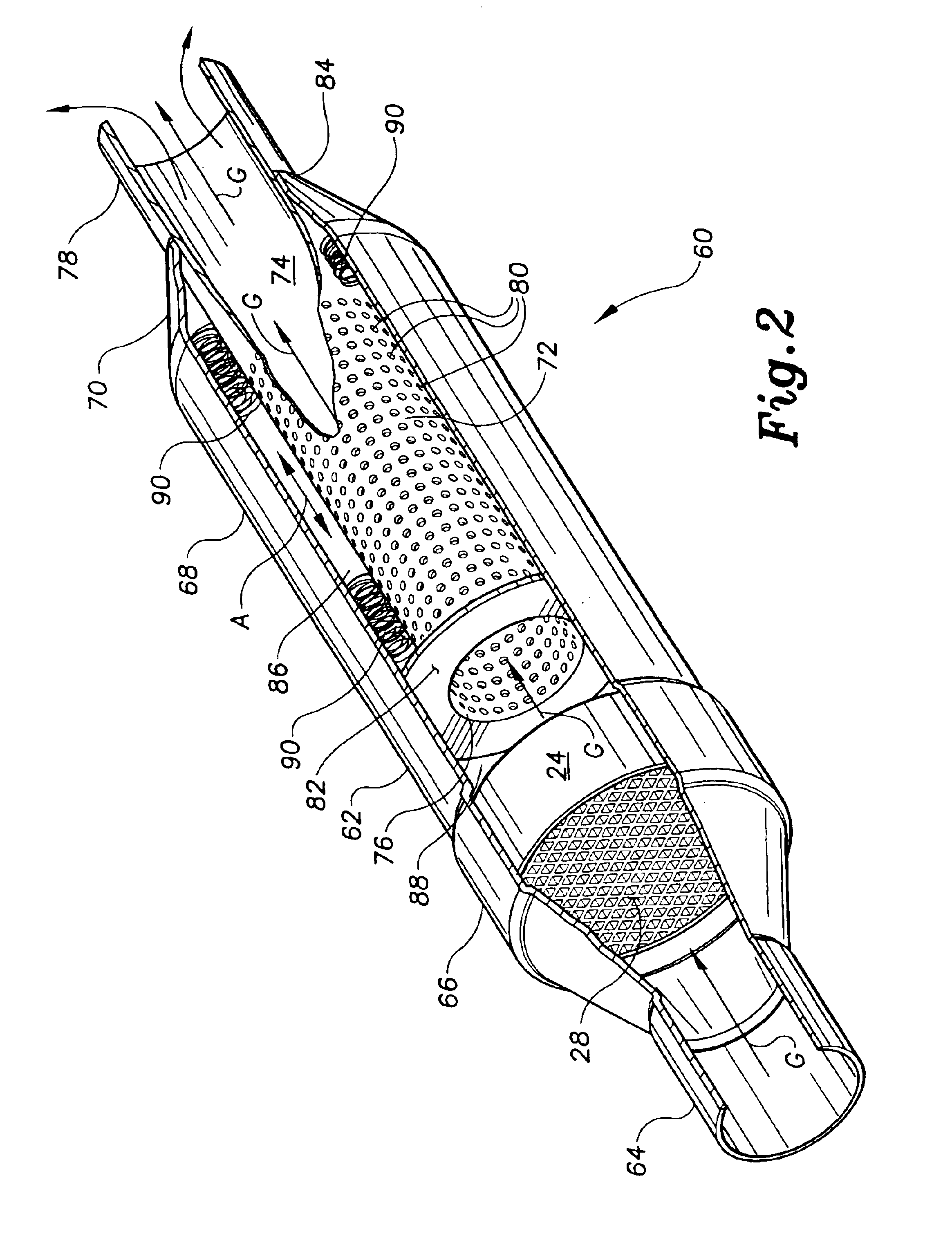Exhaust sound and emission control systems
a technology for exhaust sound and emission control, applied in the direction of machines/engines, instruments, heat measurement, etc., can solve the problems of adversely affecting the environment, not being combined into a single unit, and ever-increasing volume of automobile and truck traffic generating exhaust emissions, so as to enhance emissions reduction and reduce exhaust components
- Summary
- Abstract
- Description
- Claims
- Application Information
AI Technical Summary
Benefits of technology
Problems solved by technology
Method used
Image
Examples
embodiment 10
[0109]The remainder of the catalytic converter and resonator combination 60 of FIG. 2 is constructed similarly to the embodiment 10 of FIG. 1, with the resonator element 72 having an outer diameter substantially less than the inner diameter of the rear portion 68 of the canister 62. This difference between the inner diameter of the canister rearward portion 68 and the outer diameter of the resonator element 72, defines a sound attenuating plenum 86 therebetween. A forward sound attenuating plenum 88 is also defined between the rear of the catalytic converter element 24 and the forward end 76 of the resonator element 72 and its supporting front plate 82, within the outer shell 62 of the combination catalytic converter and resonator device 60.
[0110]The toroidal front plate 82, along with the necked down rearward end 84 of the conical rearward portion 70 of the shell 62, serve to secure the resonator pipe element 72 concentrically within the rearward portion 68 of the canister 62, with...
embodiment 100
[0118]Each of the catalytic converter elements 116 and 118 includes a substrate, respectively 124 and 126. These two substrates 124 and 126 are preferably formed in the manner described further above for the substrate 28 of the catalytic converter 24 of FIG. 1, i.e., having relatively thin walls and relatively large passage widths therebetween, as illustrated in FIG. 5. A ceramic material, such as the Dow-Corning XT described further above, may be used to form the substrates 124 and 126 of the embodiment 100 of FIG. 2. If desired, the two substrates 124 and 126 may utilize different coatings or washes of catalytic materials or elements thereon, and / or in different concentrations, in order to catalyze different exhaust products to differing degrees in each of the two converters 116 and 118. It will be seen that additional catalytic converter elements, not shown, may be placed in series with the two catalytic converter elements 116 and 118 of the catalytic converter and resonator comb...
embodiment 200
[0128]The forward resonator tube retaining plate 228 may be formed with a solid, impermeable periphery, as in the catalytic converter and resonator combination 10 of FIG. 1. However, an alternative is shown in the converter and resonator embodiment 200 of FIG. 4, in which both the front and rear plates 228 and 230 include a plurality of peripheral passages, respectively 236 and 238, therethrough, in the manner of the rear plate 50 of the converter and resonator combination 10 of FIG. 1, in order to allow any small amount of gases passing into the resonator plenum 232 to escape therefrom.
[0129]The catalytic converter and resonator combination 200 of FIG. 4 functions essentially like the converter and resonator 10 of FIG. 1, with exhaust gases G entering the canister 202 through the dual inlet pipes 212 of the inlet end 204, and thence passing through the single catalytic converter element 216. (While the single oval shaped converter element 216 is generally shaped to fit more convent...
PUM
 Login to View More
Login to View More Abstract
Description
Claims
Application Information
 Login to View More
Login to View More - R&D
- Intellectual Property
- Life Sciences
- Materials
- Tech Scout
- Unparalleled Data Quality
- Higher Quality Content
- 60% Fewer Hallucinations
Browse by: Latest US Patents, China's latest patents, Technical Efficacy Thesaurus, Application Domain, Technology Topic, Popular Technical Reports.
© 2025 PatSnap. All rights reserved.Legal|Privacy policy|Modern Slavery Act Transparency Statement|Sitemap|About US| Contact US: help@patsnap.com



